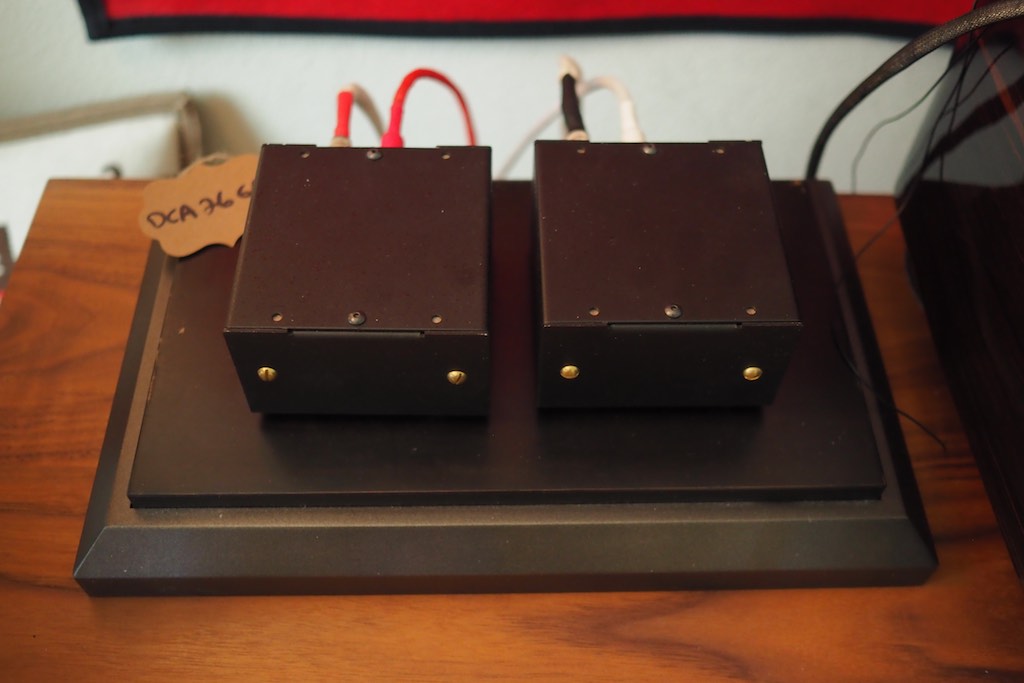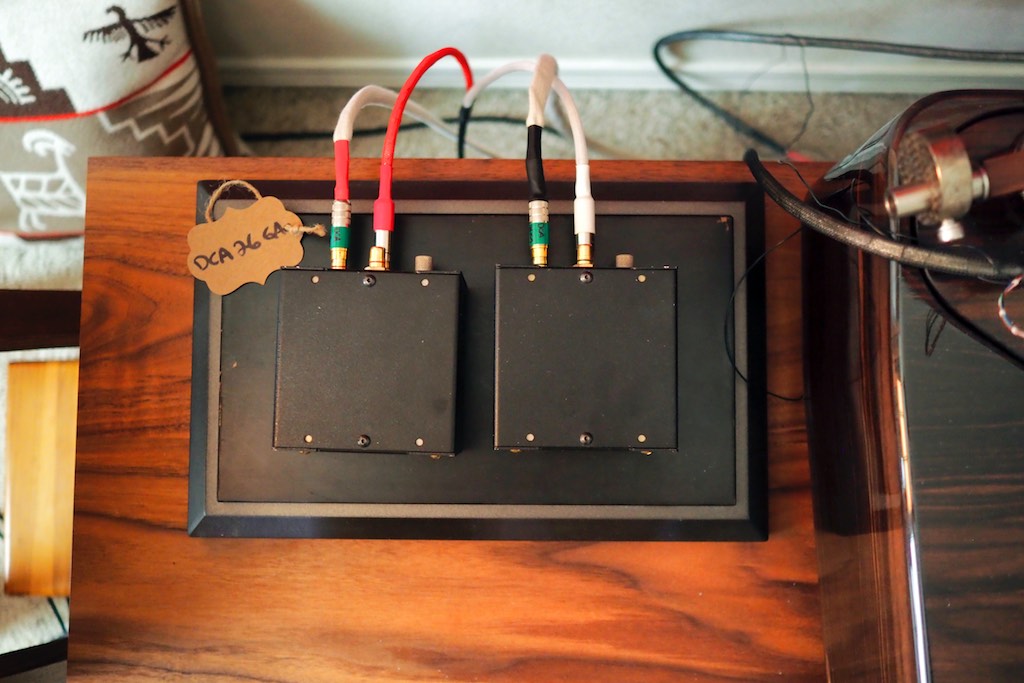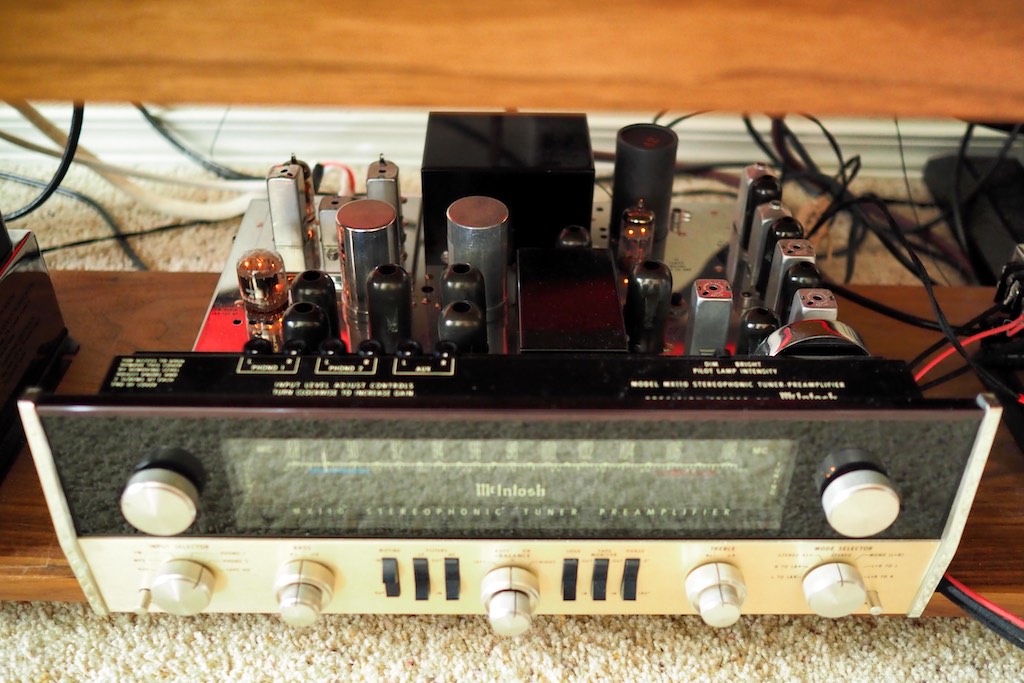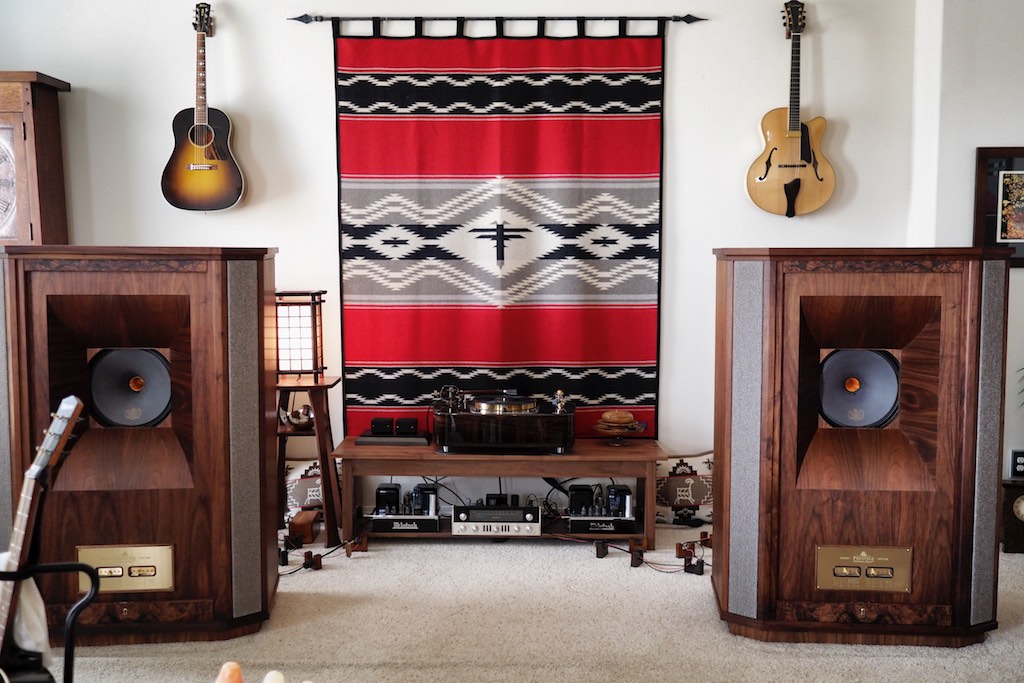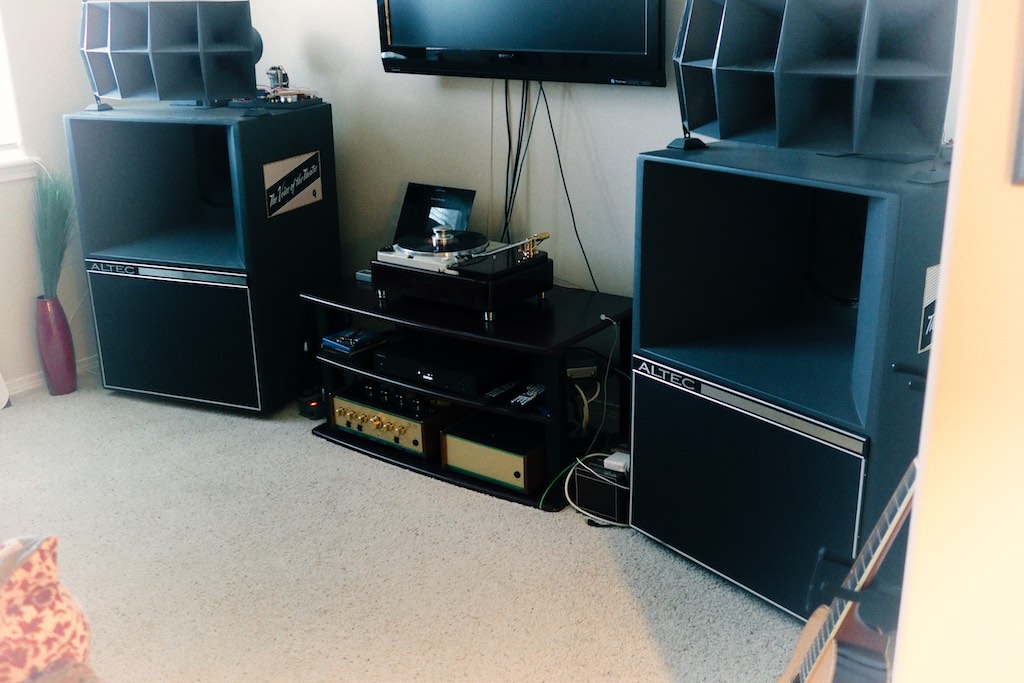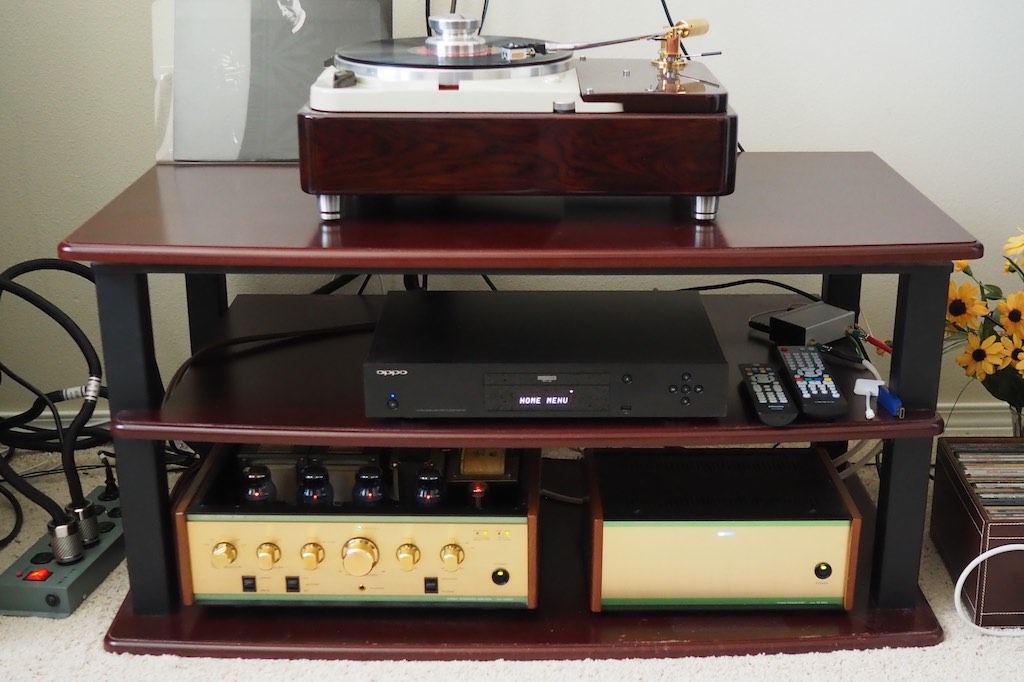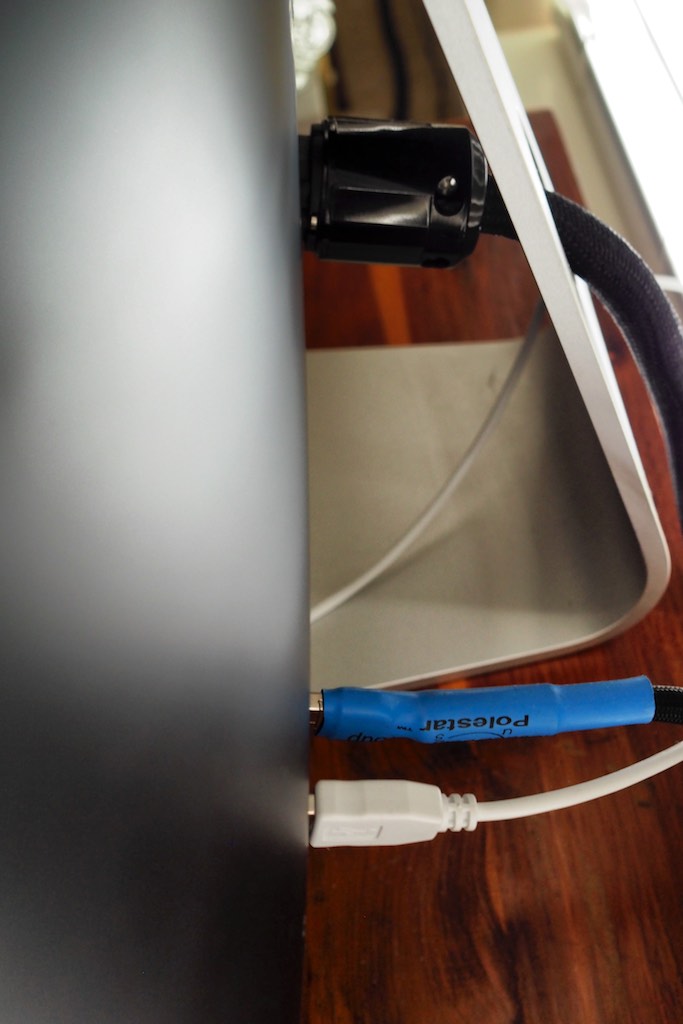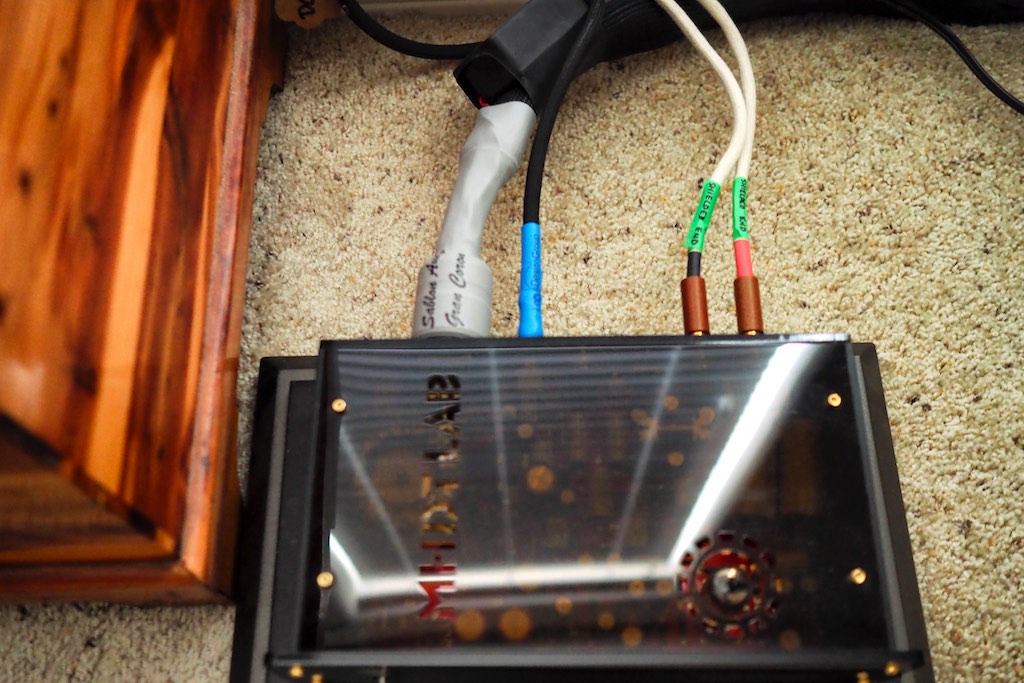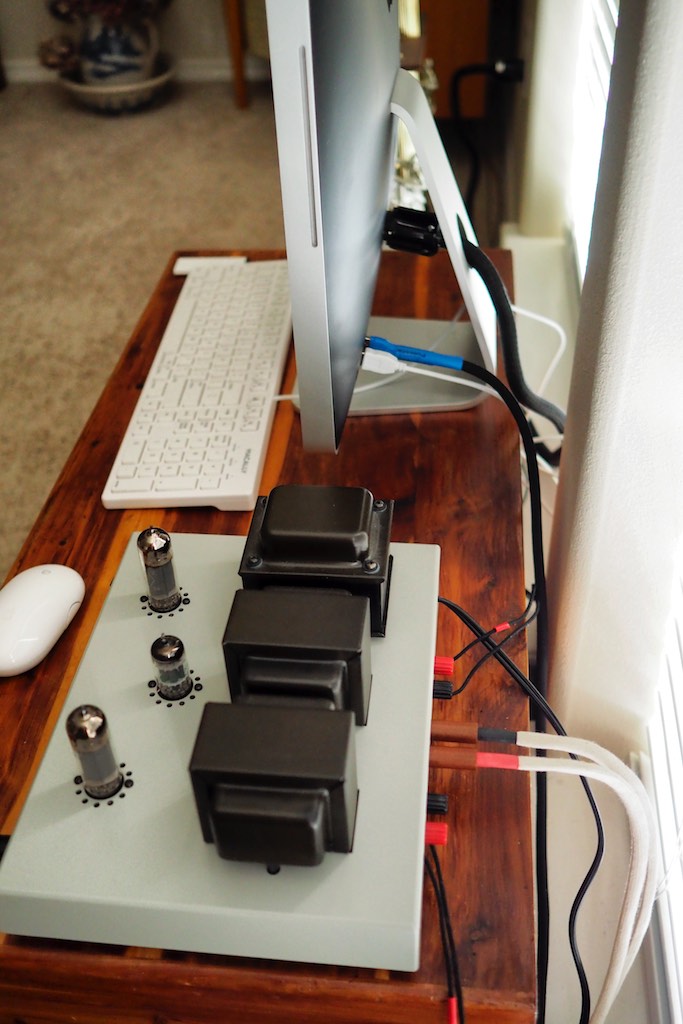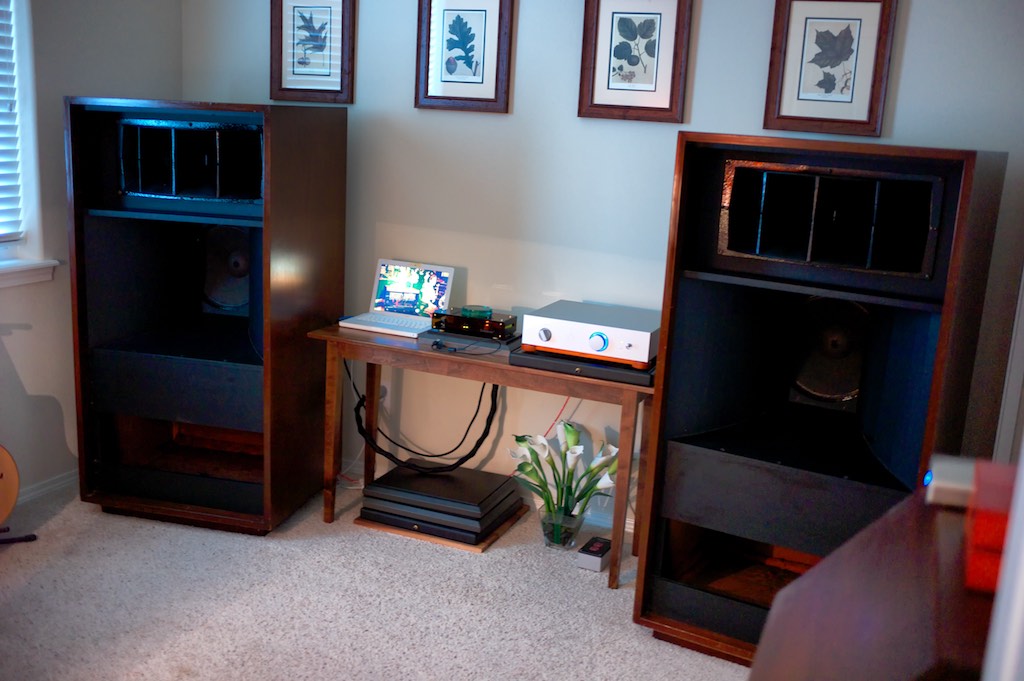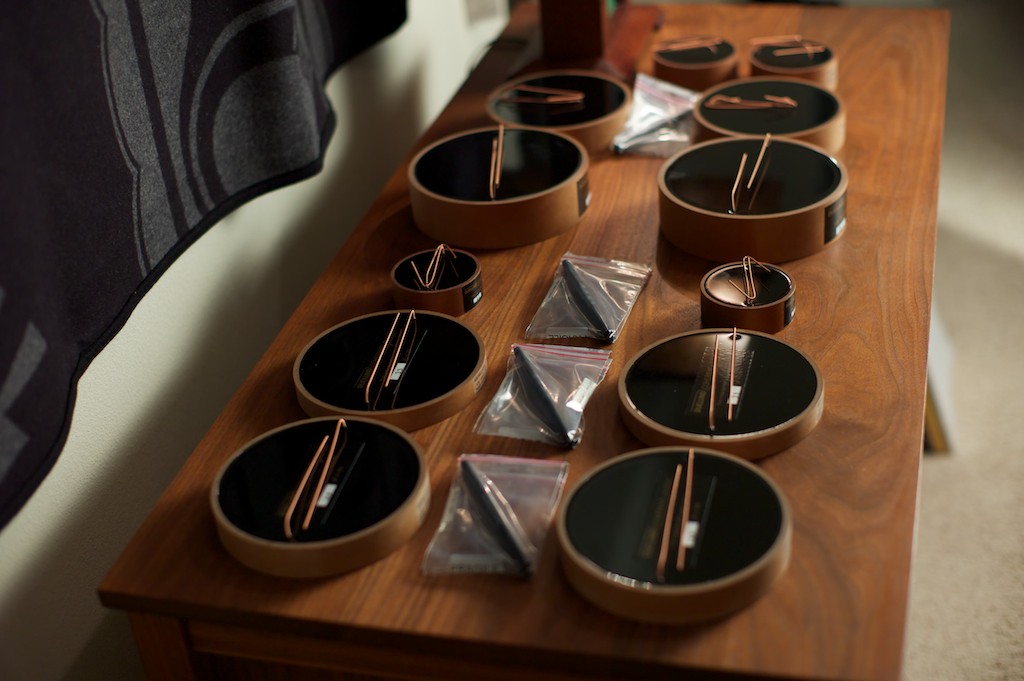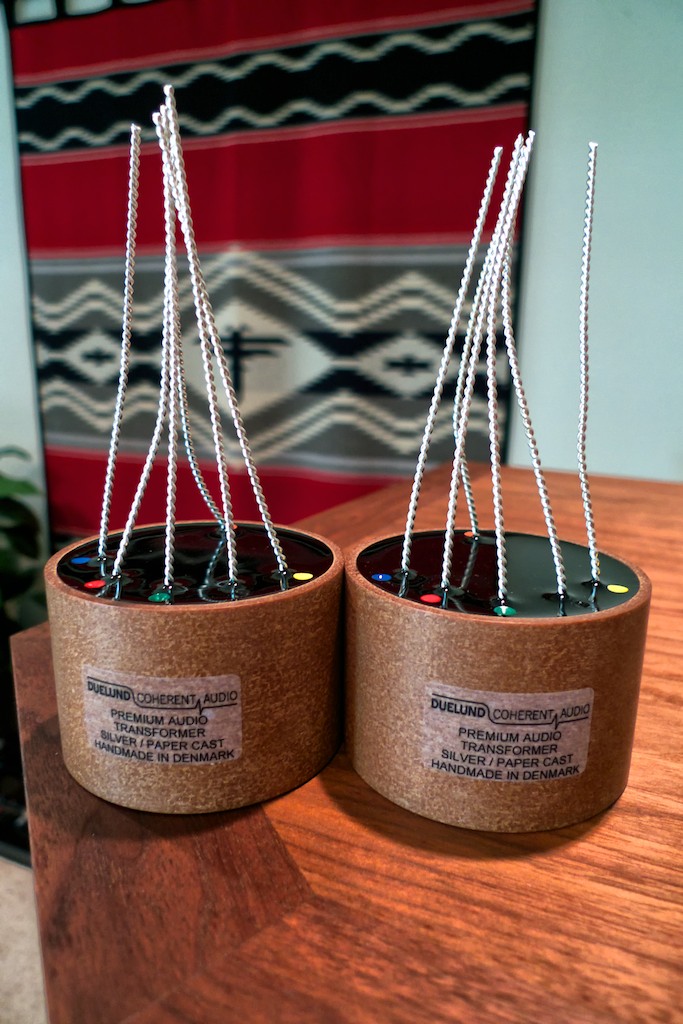As I've mentioned in previous posts, I've been having fun trying different wiring schemes with my Tannoy Westminster Royal SE loudspeakers and their Duelund CAST crossovers, as well as my vintage Altec based systems.
Tannoy Westminster Royal SE based system:
My living room music system is composed of Tannoy Westminster Royal SE loudspeakers with outboard Duelund CAST crossovers, combined with vintage McIntosh electronics, and a CTC "Garrard" 301 turntable.
As I mentioned in an earlier post, I tried putting Duelund DCA12GA tinned-copper wire in the HF section of the crossovers just to see what would happen.
It's a bit of a crazy idea to put that big of wire in a HF crossover circuit, but I thought it'd be a fun experiment.
The DCA12GA did some impressive things with sense of recorded space and textures, but I decided it was too much of a good thing. and took out the first length of DCA12GA in the HF circuit and replaced it with the DCA20GA that I was originally using there

Duelund CAST HF crossover circuit with Duelund DCA20GA (lower left) and Duelund DCA12GA (lower right).
The combination of DCA20GA & DCA12GA sounds nice, and as you would expect splits the difference between the big sense of recorded space & textures of the DCA12GA and the smooth & articulate presentation of the HF's with the DCA20GA, to give a really nice overall presentation musically & sonically.
The next thing I decided to try was a pair of shielded Duelund DCA26GA interconnects from the Intact Audio dual mono SUTs to my vintage McIntosh MX110Z in place of the shielded pairs of DCA16GA & DCA20GA interconnects I have been experimenting with in that position.
The pair of shielded pair of DCA26GA interconnects provided a really nice result in that position, and combined with the HF crossover combo of DCA12GA & DCA20GA, on Gillian Welch’s and David Rawlings’ The Harrow & The Harvest, for example, gave an impressively articulate presentation possessing natural warmth, impressive timbral realism, a real sense of touch upon the guitar strings, and a rather wonderful portrayal of melody, tempo, and harmony, that provided big emotional impact from the music in terms of artistic nuance. A wow moment for sure!
I had a bit of a vacuum tube issue with my vintage McIntosh MX110Z during this trial that confused me for a little bit (left channel was intermittently cutting out). At first I thought it was a wiring issue due to a screwup on my part, until I traced it back to the MX110Z.
When you're dealing with 17 tubes it might seem daunting to figure out what's going on, but it's actually not too bad as there's likely suspects for misbehavior (the 6U8's are notorious for relatively short life spans compared to the other tubes).
The first thing I did was, one by one, pull each tube out and clean the pins with some CAIG DeoxIT D5, and then reinstall them. Presto, the issue vanished and has not returned! So it was an issue of tube pins not making good contact, an easy fix.
Since I had my stash of CAIG out I also did a quick lube of the volume pot with CAIG F5 fader lube, as it has been getting a bit noisy of late.
Moral of the story: Use a little appropriate CAIG DeoxIT to keep all your connections happy from time-to-time.
The MX110Z tube diversion got me to thinking about doing a little for fun tube rolling with the MX110Z, so I contacted Dale at Radio Electric Supply, my favorite NOS tube purveyor. I might also add that RES's prices are very fair, and they don't gouge you price-wise like some NOS tube sellers do.
I ordered a selection of tubes to experiment with: Some GE 6EA8's (which is a substitute for the 6U8 / 6U8A you find in MX110's) for use in V16 & V17. They're supposed to be richer and less bright than the RCA 6U8 black plates that I also ordered, which can make them a nice match to Tannoy's HF's. I also ordered an RCA 12AT7/ECC81 black plate & G.E. 12AT7/ECC81 2 mica grey plate to try in V2 for kicks.
Update: Dale at Radio Electric Supply is so awesome, my tube order arrived 2 days after I ordered, by USPS Priority Mail 3-Day, and it was only $9 USD shipping to go all the way across the USA. Kudos to both Dale and USPS!
It was quite literally in the nick of time, as one of RCA 6U8 tubes in V16 & V17 croaked minutes before they arrived. Whew, that was close!
I replaced the RCA 6U8 tubes in V11, V16, and V17 with NOS GE 6EA8's to be on the safe side, as the 6U8 tubes in those positions have a reputation for going bad.
I'll report back in another post after I get a little time in on the NOS 6EA8's and get a handle on their sonics / musicality compared to the RCA 6U8's.
Ok, to get back on topic, my Westminster's are sounding freaky good right now with my Duelund DCA tweaks.
Here's what I'm using in the Westminster Royal SE system right now for wiring:
- Shielded Duelund DCA26GA interconnects from SUTs to MX110Z.
- Duelund DCA20GA interconnects from MX110Z to MC30 monaural amplifiers.
- Duelund DCA12GA speaker cables from MC30 monaural amplifiers to the Duelund CAST external crossovers.
- Duelund DCA16GA in the LF section of the Duelund CAST external crossovers.
- Mix of Duelund DCA12GA & DCA20GA in the HF section of the Duelund CAST crossovers, as described above.
- Western Electric WE16GA Westminster internal wiring connecting the drivers to the external Duelund CAST crossovers (a BIG job to change).
I envision trying the Duelund DCA12GA in the LF crossover in place of the DCA16GA as a next DCA experiment, and then finally replacing the WE16GA Westminster wiring with DCA wiring, but that one's a big job, so it may be a while.
Vintage Altec A5 Voice of the Theatre based system:
I just updated what I'm using in my A5 based audio-video system HERE if you're interested in the details.
For the video portion of the system I'm using the following wiring:
- Belden 8402 microphone cable interconnects to connect the Philips TV to the Leben CS600, and the Leben CS600 to the Oppo, which is providing really glorious "classic theater" sound from the digital front end.
For the analog portion of the system I'm using the following wiring:
- Shielded Duelund DCA20GA interconnects connect my Auditorium 23 SUT for the Audio MusiKraft Denon DL-103 to the Leben RS30EQ phono preamplifier.
- Shielded pair of Duelund DCA16GA interconnects connect the RS30EQ to the Leben CS600 integrated amplifier.
For the rest of the system:
- Duelund DCA16 speaker cables connect the CS600 integrated amplifier to the Altec A5 crossovers.
- The Altec A5 "Hiraga-inspired" crossovers are wired internally with Western Electric WE16GA.
- The Altec A5 drivers are wired internally with Western Electric WE16GA.
I'm really happy with the sound I'm getting from my digital front end for video, which sounds huge, articulate, and very well balanced top-to-bottom, producing lots of move "Wow!" moments.
I'm still working on getting the exact HF smoothness that I want on the analog front end. It sounds good, actually, but I still think I can do better.
I'm thinking that a combination of Duelund DCA20GA for the HF crossover circuits, and a little tube rolling for the Leben RS30EQ phono preamplifier, are logical next steps.
I'll keep you posted on those as I proceed.
Vintage Altec 832A Corona Based System:
I have been really enjoying my vintage Altec 832A Corona based bedroom system. The Corona's fill the room with beautiful jazz in such a fine way that I'm really happy with the results.
The room corners are far enough apart that it's hard to get a photo of both of the Corona's in it at the same time!
Even with their wide spacing the Corona's fill the room with music with no lack of center fill.
I'm just getting started with this system, but the results so far are really encouraging.
Here's what I'm using for wiring:
- Locus Design Group Polestar USB interconnect between iMac & Mhdt Lab Paradisea+ USB DAC
- Shielded Duelund DCA16GA interconnect between the Paradisea+ USB DAC and Almarro A205A integrated amplifier.
- Duelund DCA16GA speaker cables between the Almarro A205A integrated amp and the Altec 832A Corona loudspeakers.
I'm just getting started with this Altec 832A Corona based system, but I love what I'm hearing from it!
The most obvious change for the better for the Corona's would be switching from the stock vintage Altec crossovers to a Hiraga-inspired crossover.
As I mentioned in an earlier post, Pete Riggle is working on developing some Hiraga-inspired crossovers optimized for 800 Hz horns like the Corona's have, as well as many other domestic vintage Altec loudspeakers.
Pete has an uncanny ability to get great sound & musicality out of every pair of loudspeakers he's developed crossovers for, so I'm thinking his 800 Hz crossover design will be a real asset for vintage domestic Altec owners, just as his A7 & A5 crossovers have been.
Pete's really got some really great ideas that allow optimizing the crossover to various domestic Altec designs. Pete's way behind schedule on this project, but I'll keep you posted on any news as it develops.
Along with crossover upgrades, upgrading the internal wiring of the Corona's to Duelund DCA would be a big improvement.
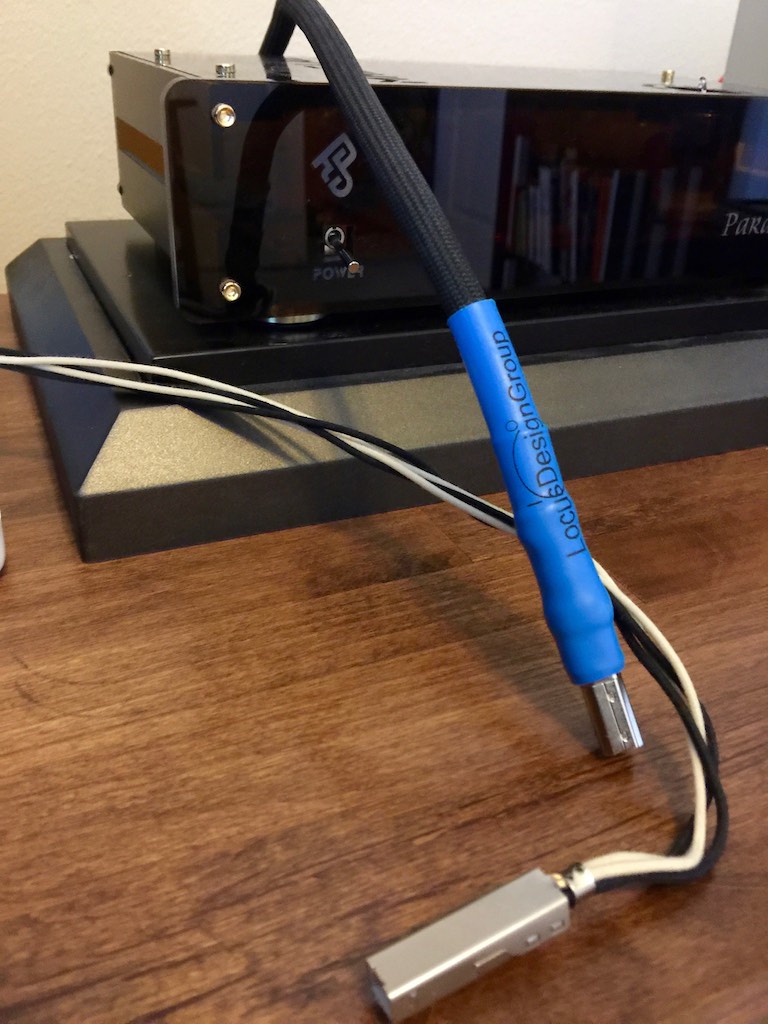
My DIY 'pushback wire' USB interconnect has outperformed every USB interconnect I've tried and it cost less than $10 to build.
I also want to build another Art of Tone tinned-copper USB interconnect for this system like I did for the my Altec A7 "Stokowski" Voice of the Theatre loudspeaker based system that I described HERE. This inexpensive interconnect blows away every other USB interconnect I have, but the little USB connections make it a challenge to solder. It's well worth the effort though!
I'll keep you posted on developments as I continue experimenting with the vintage Altec 832A Corona's based system, it should be fun!
Altec A7 "Stokowski" Voice of the Theatre Based System:
The vintage Altec A7 Voice of the Theatre loudspeakers that were made for Leopold Stokowski back when he lived in New York are wondrous things. These are my first Altec loudspeakers, and they turned me into an instant vintage Altec loudspeaker nut!
These Altec A7's have influenced a wave of vintage Altec interest among my audio pals, and for good reason, as they sound wonderful powered by the SPEC RSA-M3 EX integrated amplifier!
At the moment, I'm using the aforementioned Art of Tone USB interconnect with my Mhdt Havana USB DAC, Belden 8402 microphone cable interconnects from the DAC to the SPEC RSA-M3 EX, and Western Electric WE16GA speaker cables from the SPEC to the Altec's. It sounds really nice!
These massively historically significant Altec A7 loudspeakers will be the result of by far the most ambitious and exciting project I have on the horizon, the Duelund Coherent Audio & Stokowski Altec Project, that will be exclusively utilizing custom Duelund tinned-copper components to build Hiraga-inspired crossovers for the vintage Altec "Stokowski" A7's.
If you followed the Duelund-Westminster Crossover Project, you know how much effort goes into producing custom Duelund components, so it takes a while to get all the components built.
Like Pete with his 800 Hz crossover project, Frederick tells me he is also behind schedule on building the components for this project.
Frederik tells me that he is being very careful as he proceeds with building the components, as this will be a world-first showcase of crossovers built exclusively from custom Duelund tinned-copper components!
Ok, I guess that's it for now. There's lots of good things coming, so stay tuned!
As always, thanks for stopping by, and may the tone be with you!






